PGDM Assignment: Impact of COVID-19 on K-12 Education in India
VerifiedAdded on 2021/07/28
|17
|3003
|228
Report
AI Summary
This report provides a detailed analysis of the impact of the COVID-19 crisis on the K-12 education sector in India. It examines the shift towards digitization, the rise of educational apps, and the disruption of educational activities. The report identifies the affected stakeholders, including students, parents, teachers, and staff, and discusses the challenges they faced. It also outlines various initiatives undertaken by both the government and private sectors to address the crisis, such as the use of radio for educational programs and the promotion of online learning platforms like DIKSHA and SWAYAM. The report further highlights the drawbacks of these initiatives and offers recommendations for the future, emphasizing the need for a robust and resilient education system that can navigate future crises. The report concludes by stressing the importance of addressing the digital divide and ensuring equitable access to education for all students.
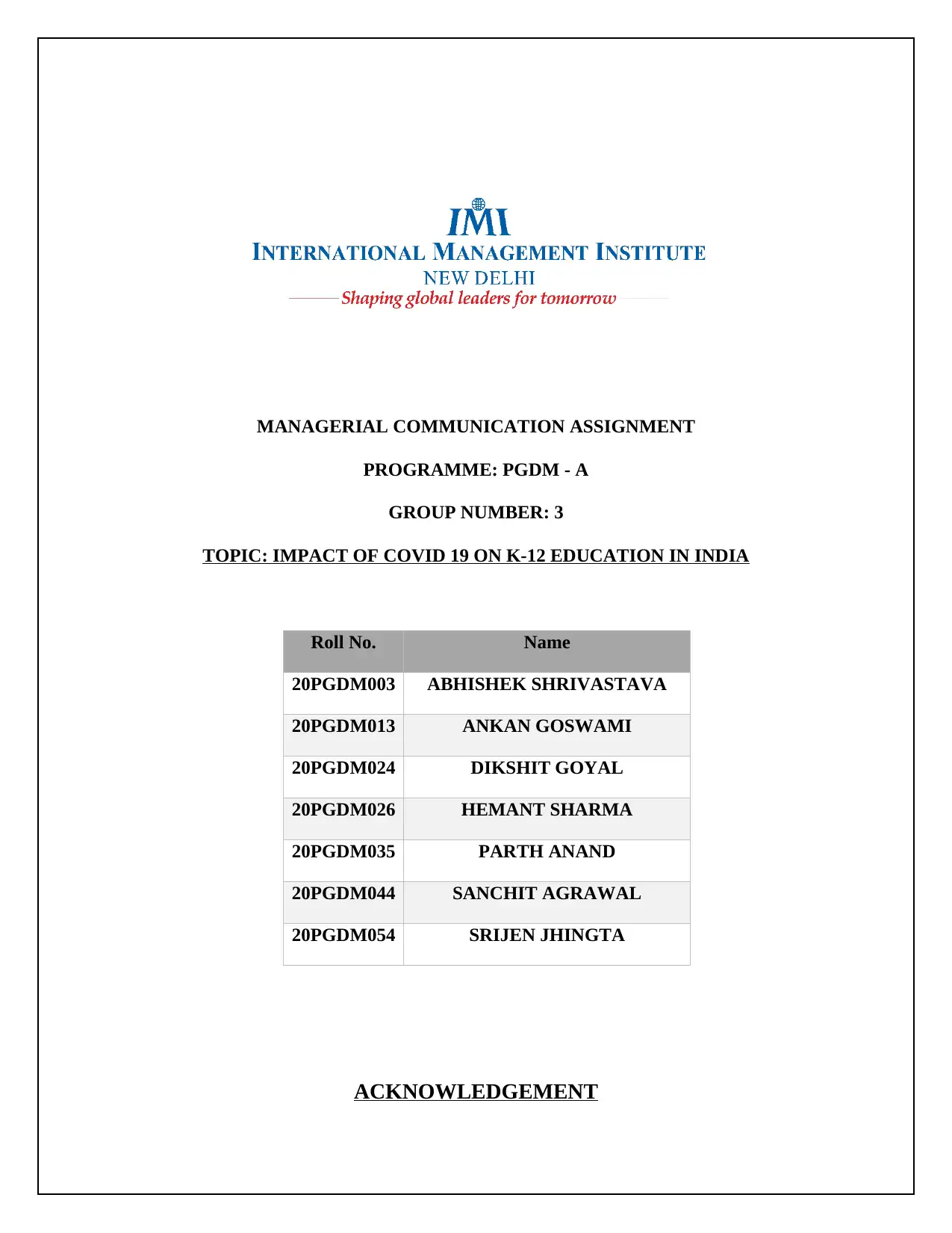
MANAGERIAL COMMUNICATION ASSIGNMENT
PROGRAMME: PGDM - A
GROUP NUMBER: 3
TOPIC: IMPACT OF COVID 19 ON K-12 EDUCATION IN INDIA
Roll No. Name
20PGDM003 ABHISHEK SHRIVASTAVA
20PGDM013 ANKAN GOSWAMI
20PGDM024 DIKSHIT GOYAL
20PGDM026 HEMANT SHARMA
20PGDM035 PARTH ANAND
20PGDM044 SANCHIT AGRAWAL
20PGDM054 SRIJEN JHINGTA
ACKNOWLEDGEMENT
PROGRAMME: PGDM - A
GROUP NUMBER: 3
TOPIC: IMPACT OF COVID 19 ON K-12 EDUCATION IN INDIA
Roll No. Name
20PGDM003 ABHISHEK SHRIVASTAVA
20PGDM013 ANKAN GOSWAMI
20PGDM024 DIKSHIT GOYAL
20PGDM026 HEMANT SHARMA
20PGDM035 PARTH ANAND
20PGDM044 SANCHIT AGRAWAL
20PGDM054 SRIJEN JHINGTA
ACKNOWLEDGEMENT
Paraphrase This Document
Need a fresh take? Get an instant paraphrase of this document with our AI Paraphraser
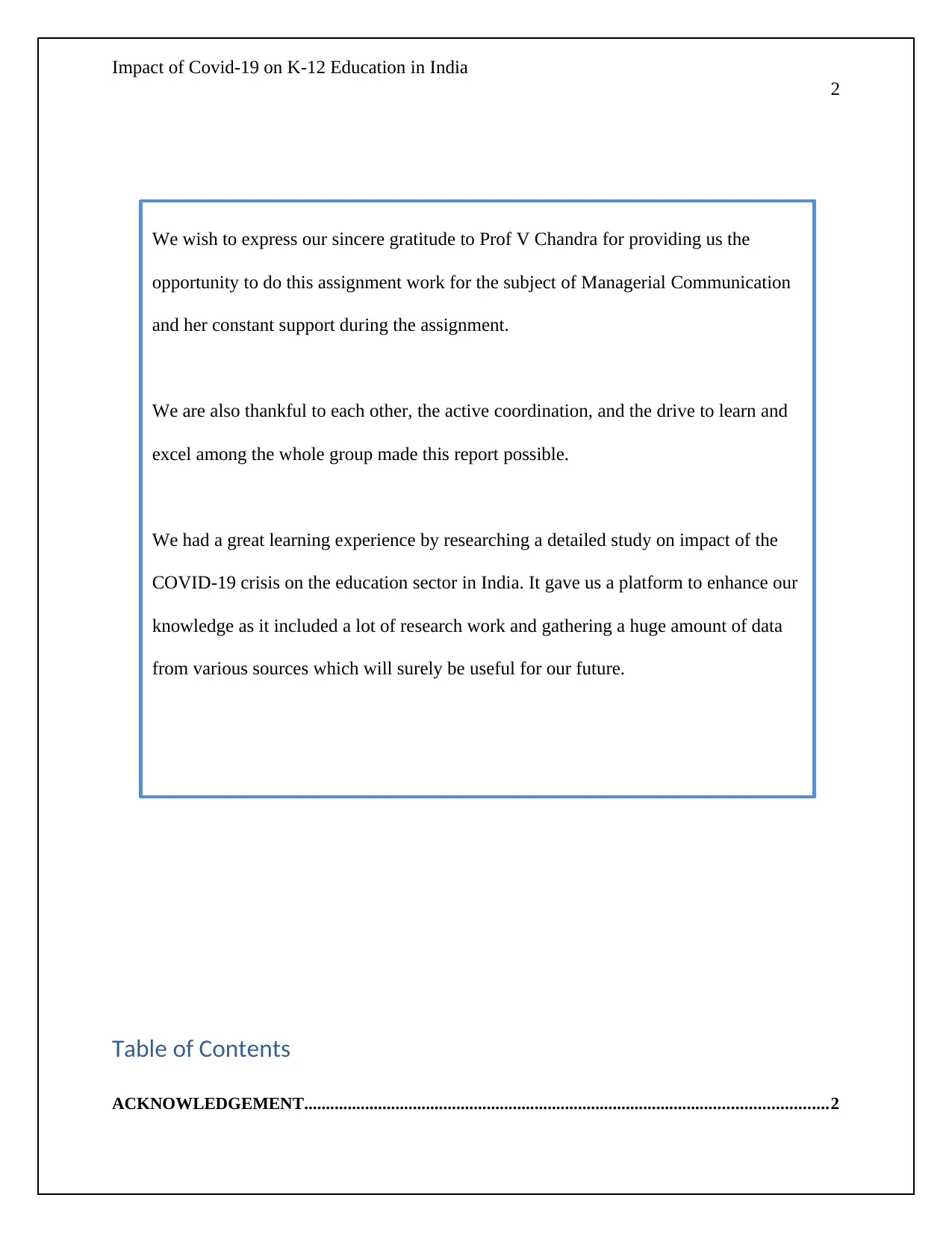
Impact of Covid-19 on K-12 Education in India
2
Table of Contents
ACKNOWLEDGEMENT........................................................................................................................2
We wish to express our sincere gratitude to Prof V Chandra for providing us the
opportunity to do this assignment work for the subject of Managerial Communication
and her constant support during the assignment.
We are also thankful to each other, the active coordination, and the drive to learn and
excel among the whole group made this report possible.
We had a great learning experience by researching a detailed study on impact of the
COVID-19 crisis on the education sector in India. It gave us a platform to enhance our
knowledge as it included a lot of research work and gathering a huge amount of data
from various sources which will surely be useful for our future.
2
Table of Contents
ACKNOWLEDGEMENT........................................................................................................................2
We wish to express our sincere gratitude to Prof V Chandra for providing us the
opportunity to do this assignment work for the subject of Managerial Communication
and her constant support during the assignment.
We are also thankful to each other, the active coordination, and the drive to learn and
excel among the whole group made this report possible.
We had a great learning experience by researching a detailed study on impact of the
COVID-19 crisis on the education sector in India. It gave us a platform to enhance our
knowledge as it included a lot of research work and gathering a huge amount of data
from various sources which will surely be useful for our future.
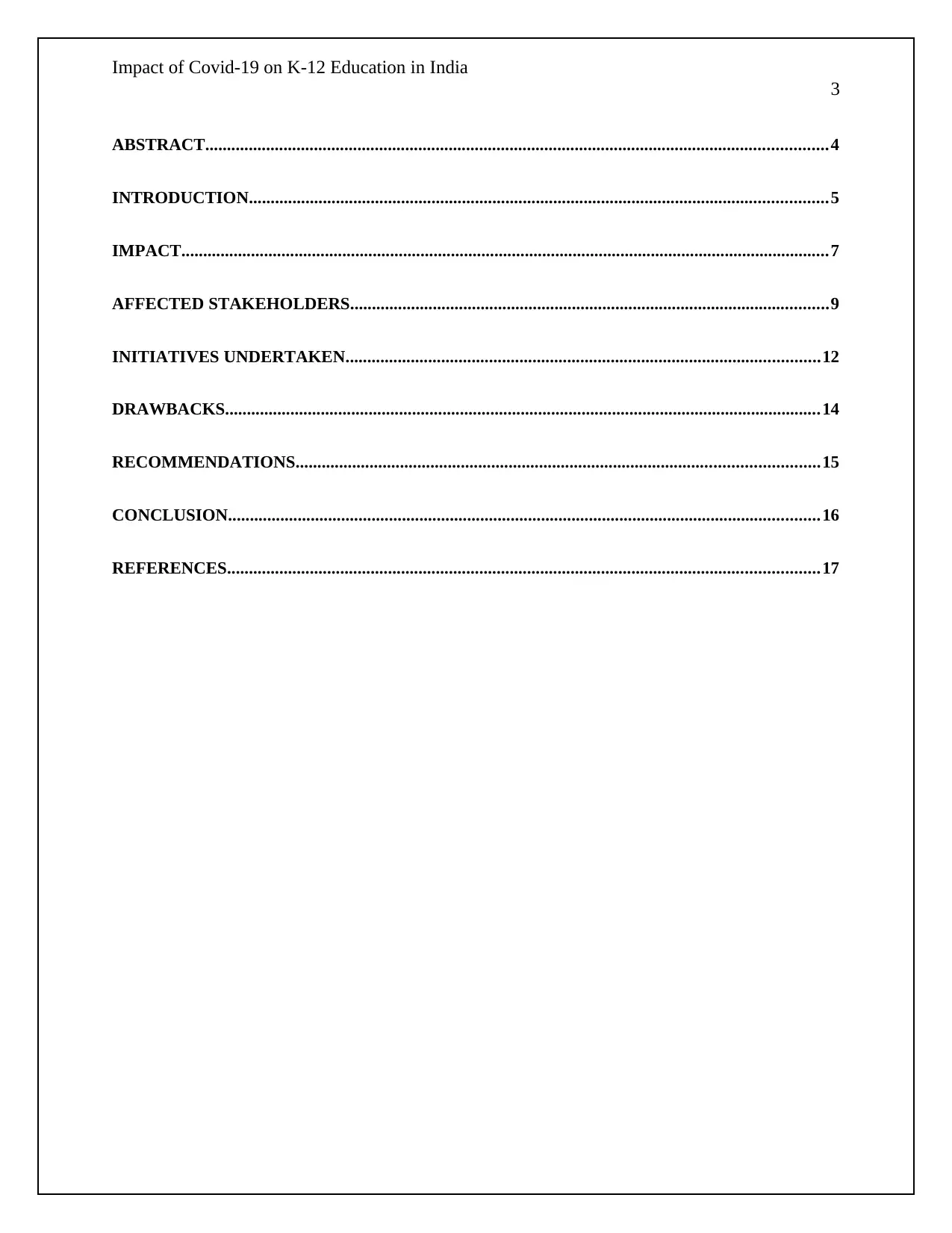
Impact of Covid-19 on K-12 Education in India
3
ABSTRACT...............................................................................................................................................4
INTRODUCTION.....................................................................................................................................5
IMPACT.....................................................................................................................................................7
AFFECTED STAKEHOLDERS..............................................................................................................9
INITIATIVES UNDERTAKEN.............................................................................................................12
DRAWBACKS.........................................................................................................................................14
RECOMMENDATIONS........................................................................................................................15
CONCLUSION........................................................................................................................................16
REFERENCES........................................................................................................................................17
3
ABSTRACT...............................................................................................................................................4
INTRODUCTION.....................................................................................................................................5
IMPACT.....................................................................................................................................................7
AFFECTED STAKEHOLDERS..............................................................................................................9
INITIATIVES UNDERTAKEN.............................................................................................................12
DRAWBACKS.........................................................................................................................................14
RECOMMENDATIONS........................................................................................................................15
CONCLUSION........................................................................................................................................16
REFERENCES........................................................................................................................................17
⊘ This is a preview!⊘
Do you want full access?
Subscribe today to unlock all pages.

Trusted by 1+ million students worldwide
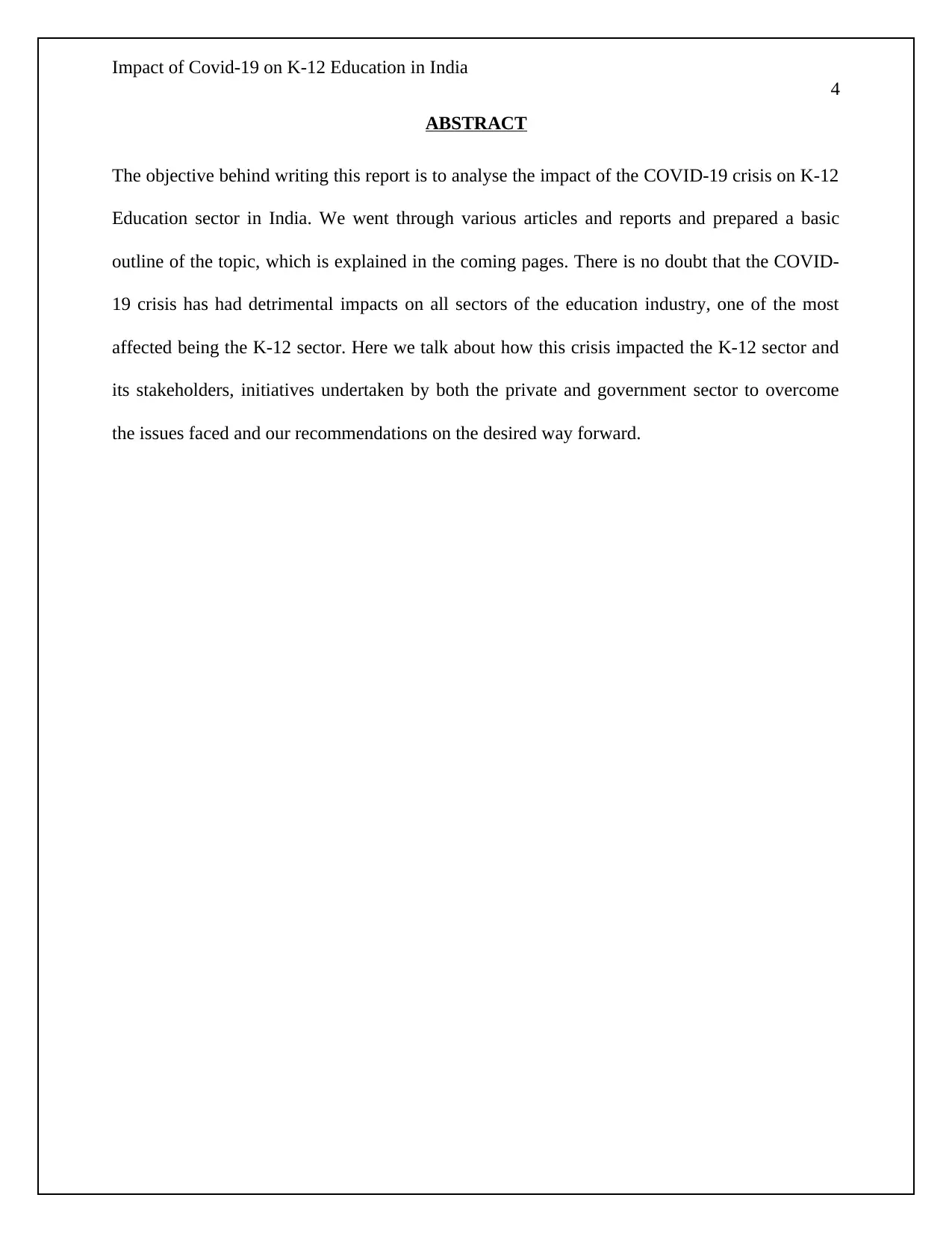
Impact of Covid-19 on K-12 Education in India
4
ABSTRACT
The objective behind writing this report is to analyse the impact of the COVID-19 crisis on K-12
Education sector in India. We went through various articles and reports and prepared a basic
outline of the topic, which is explained in the coming pages. There is no doubt that the COVID-
19 crisis has had detrimental impacts on all sectors of the education industry, one of the most
affected being the K-12 sector. Here we talk about how this crisis impacted the K-12 sector and
its stakeholders, initiatives undertaken by both the private and government sector to overcome
the issues faced and our recommendations on the desired way forward.
4
ABSTRACT
The objective behind writing this report is to analyse the impact of the COVID-19 crisis on K-12
Education sector in India. We went through various articles and reports and prepared a basic
outline of the topic, which is explained in the coming pages. There is no doubt that the COVID-
19 crisis has had detrimental impacts on all sectors of the education industry, one of the most
affected being the K-12 sector. Here we talk about how this crisis impacted the K-12 sector and
its stakeholders, initiatives undertaken by both the private and government sector to overcome
the issues faced and our recommendations on the desired way forward.
Paraphrase This Document
Need a fresh take? Get an instant paraphrase of this document with our AI Paraphraser
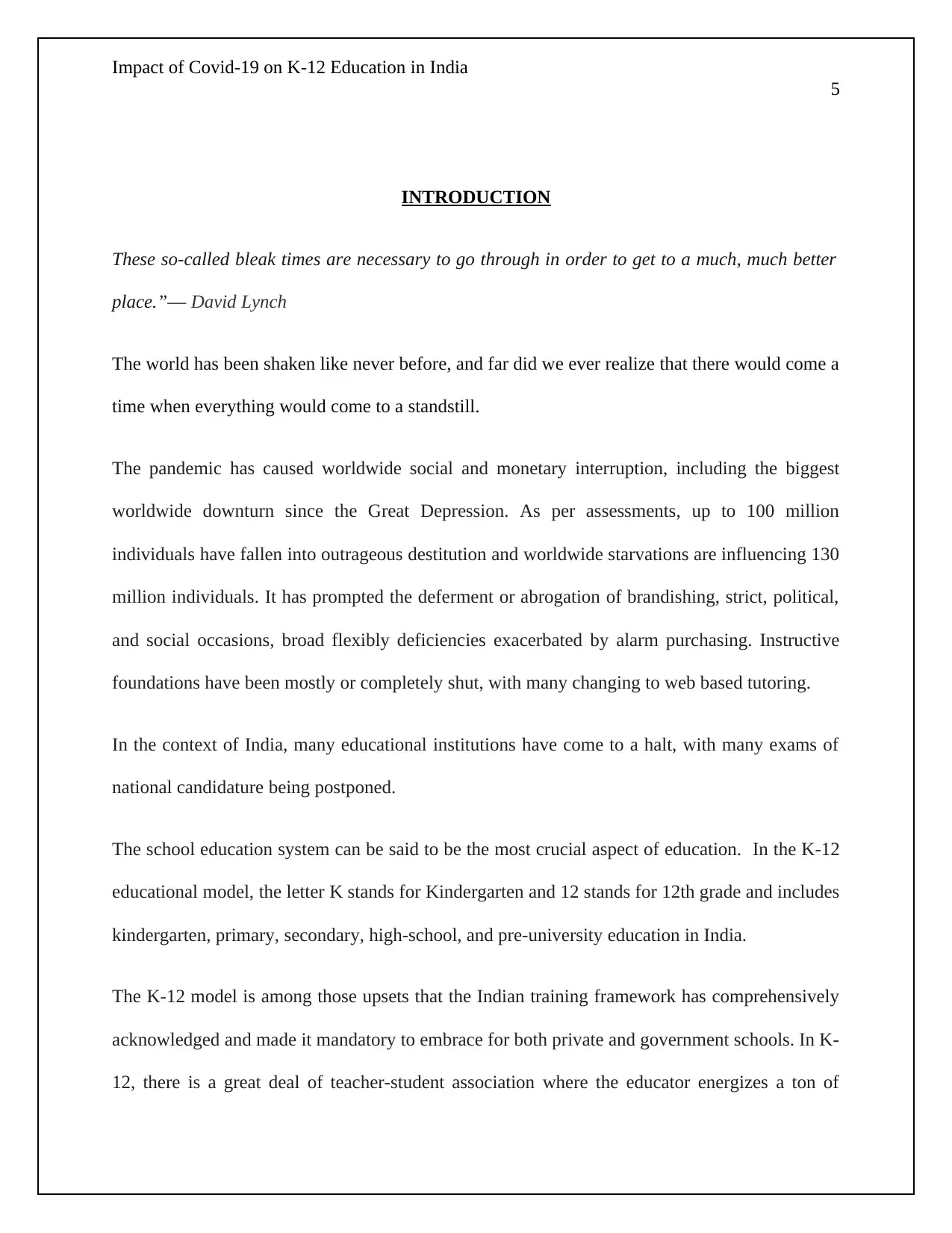
Impact of Covid-19 on K-12 Education in India
5
INTRODUCTION
These so-called bleak times are necessary to go through in order to get to a much, much better
place.”― David Lynch
The world has been shaken like never before, and far did we ever realize that there would come a
time when everything would come to a standstill.
The pandemic has caused worldwide social and monetary interruption, including the biggest
worldwide downturn since the Great Depression. As per assessments, up to 100 million
individuals have fallen into outrageous destitution and worldwide starvations are influencing 130
million individuals. It has prompted the deferment or abrogation of brandishing, strict, political,
and social occasions, broad flexibly deficiencies exacerbated by alarm purchasing. Instructive
foundations have been mostly or completely shut, with many changing to web based tutoring.
In the context of India, many educational institutions have come to a halt, with many exams of
national candidature being postponed.
The school education system can be said to be the most crucial aspect of education. In the K-12
educational model, the letter K stands for Kindergarten and 12 stands for 12th grade and includes
kindergarten, primary, secondary, high-school, and pre-university education in India.
The K-12 model is among those upsets that the Indian training framework has comprehensively
acknowledged and made it mandatory to embrace for both private and government schools. In K-
12, there is a great deal of teacher-student association where the educator energizes a ton of
5
INTRODUCTION
These so-called bleak times are necessary to go through in order to get to a much, much better
place.”― David Lynch
The world has been shaken like never before, and far did we ever realize that there would come a
time when everything would come to a standstill.
The pandemic has caused worldwide social and monetary interruption, including the biggest
worldwide downturn since the Great Depression. As per assessments, up to 100 million
individuals have fallen into outrageous destitution and worldwide starvations are influencing 130
million individuals. It has prompted the deferment or abrogation of brandishing, strict, political,
and social occasions, broad flexibly deficiencies exacerbated by alarm purchasing. Instructive
foundations have been mostly or completely shut, with many changing to web based tutoring.
In the context of India, many educational institutions have come to a halt, with many exams of
national candidature being postponed.
The school education system can be said to be the most crucial aspect of education. In the K-12
educational model, the letter K stands for Kindergarten and 12 stands for 12th grade and includes
kindergarten, primary, secondary, high-school, and pre-university education in India.
The K-12 model is among those upsets that the Indian training framework has comprehensively
acknowledged and made it mandatory to embrace for both private and government schools. In K-
12, there is a great deal of teacher-student association where the educator energizes a ton of
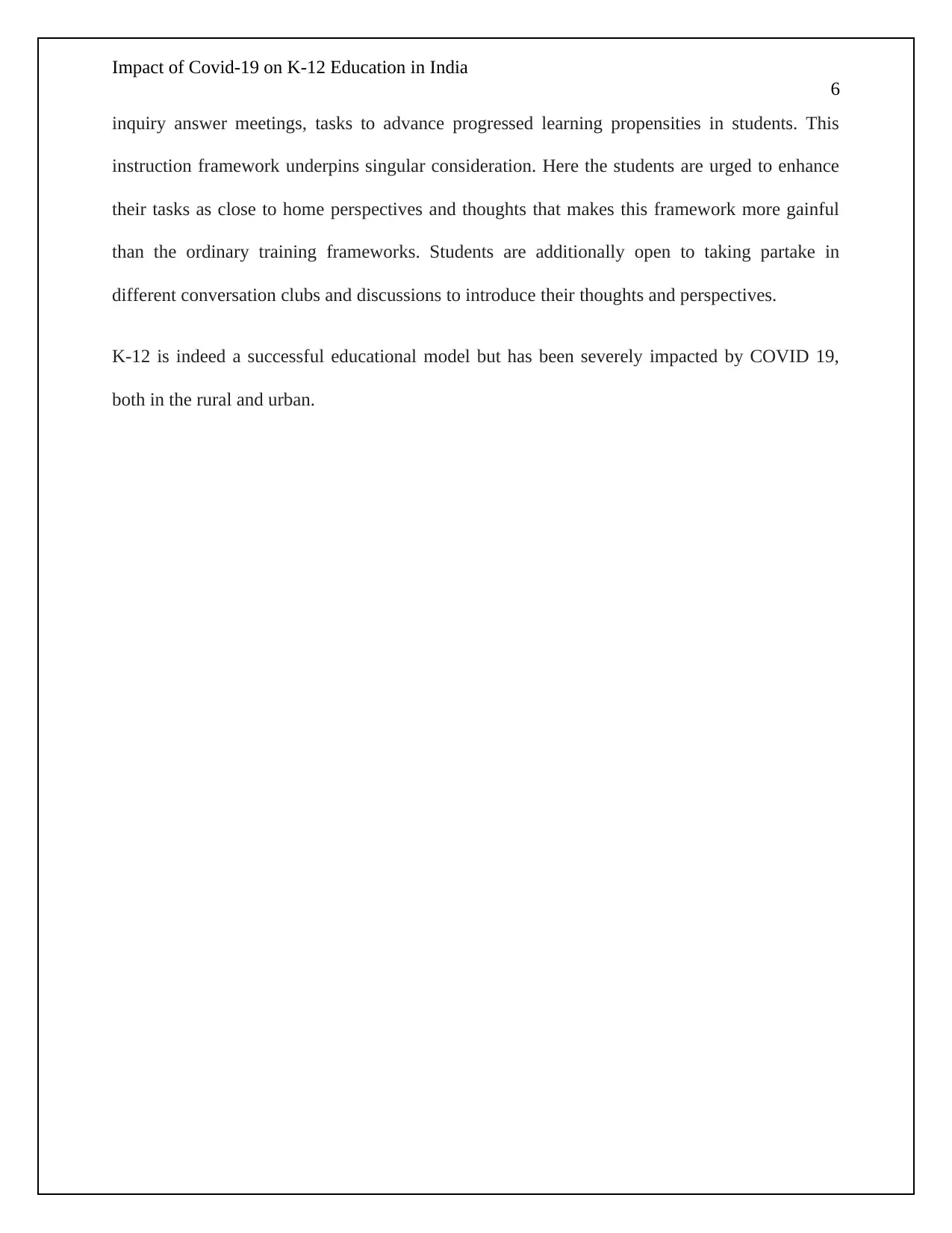
Impact of Covid-19 on K-12 Education in India
6
inquiry answer meetings, tasks to advance progressed learning propensities in students. This
instruction framework underpins singular consideration. Here the students are urged to enhance
their tasks as close to home perspectives and thoughts that makes this framework more gainful
than the ordinary training frameworks. Students are additionally open to taking partake in
different conversation clubs and discussions to introduce their thoughts and perspectives.
K-12 is indeed a successful educational model but has been severely impacted by COVID 19,
both in the rural and urban.
6
inquiry answer meetings, tasks to advance progressed learning propensities in students. This
instruction framework underpins singular consideration. Here the students are urged to enhance
their tasks as close to home perspectives and thoughts that makes this framework more gainful
than the ordinary training frameworks. Students are additionally open to taking partake in
different conversation clubs and discussions to introduce their thoughts and perspectives.
K-12 is indeed a successful educational model but has been severely impacted by COVID 19,
both in the rural and urban.
⊘ This is a preview!⊘
Do you want full access?
Subscribe today to unlock all pages.

Trusted by 1+ million students worldwide
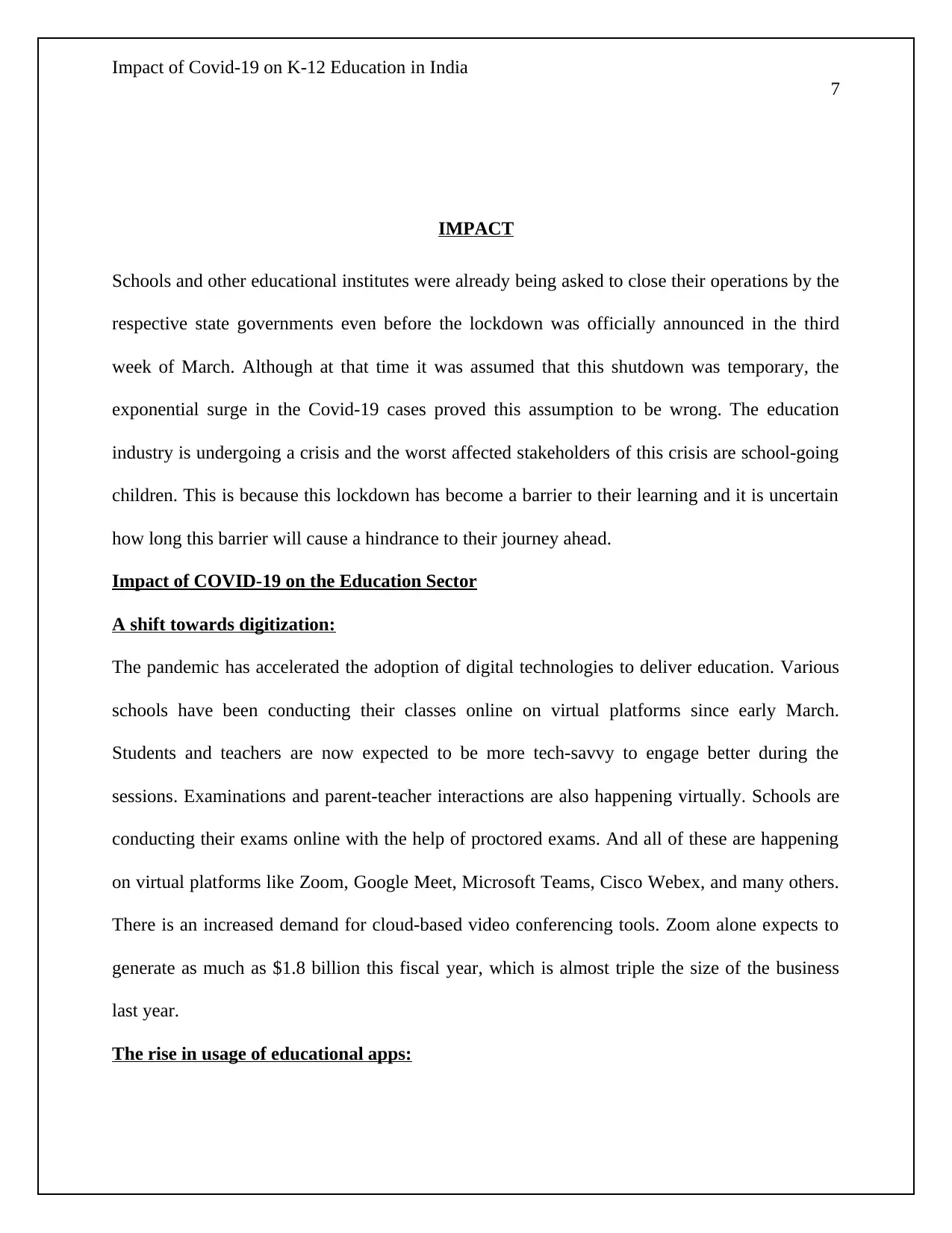
Impact of Covid-19 on K-12 Education in India
7
IMPACT
Schools and other educational institutes were already being asked to close their operations by the
respective state governments even before the lockdown was officially announced in the third
week of March. Although at that time it was assumed that this shutdown was temporary, the
exponential surge in the Covid-19 cases proved this assumption to be wrong. The education
industry is undergoing a crisis and the worst affected stakeholders of this crisis are school-going
children. This is because this lockdown has become a barrier to their learning and it is uncertain
how long this barrier will cause a hindrance to their journey ahead.
Impact of COVID-19 on the Education Sector
A shift towards digitization:
The pandemic has accelerated the adoption of digital technologies to deliver education. Various
schools have been conducting their classes online on virtual platforms since early March.
Students and teachers are now expected to be more tech-savvy to engage better during the
sessions. Examinations and parent-teacher interactions are also happening virtually. Schools are
conducting their exams online with the help of proctored exams. And all of these are happening
on virtual platforms like Zoom, Google Meet, Microsoft Teams, Cisco Webex, and many others.
There is an increased demand for cloud-based video conferencing tools. Zoom alone expects to
generate as much as $1.8 billion this fiscal year, which is almost triple the size of the business
last year.
The rise in usage of educational apps:
7
IMPACT
Schools and other educational institutes were already being asked to close their operations by the
respective state governments even before the lockdown was officially announced in the third
week of March. Although at that time it was assumed that this shutdown was temporary, the
exponential surge in the Covid-19 cases proved this assumption to be wrong. The education
industry is undergoing a crisis and the worst affected stakeholders of this crisis are school-going
children. This is because this lockdown has become a barrier to their learning and it is uncertain
how long this barrier will cause a hindrance to their journey ahead.
Impact of COVID-19 on the Education Sector
A shift towards digitization:
The pandemic has accelerated the adoption of digital technologies to deliver education. Various
schools have been conducting their classes online on virtual platforms since early March.
Students and teachers are now expected to be more tech-savvy to engage better during the
sessions. Examinations and parent-teacher interactions are also happening virtually. Schools are
conducting their exams online with the help of proctored exams. And all of these are happening
on virtual platforms like Zoom, Google Meet, Microsoft Teams, Cisco Webex, and many others.
There is an increased demand for cloud-based video conferencing tools. Zoom alone expects to
generate as much as $1.8 billion this fiscal year, which is almost triple the size of the business
last year.
The rise in usage of educational apps:
Paraphrase This Document
Need a fresh take? Get an instant paraphrase of this document with our AI Paraphraser
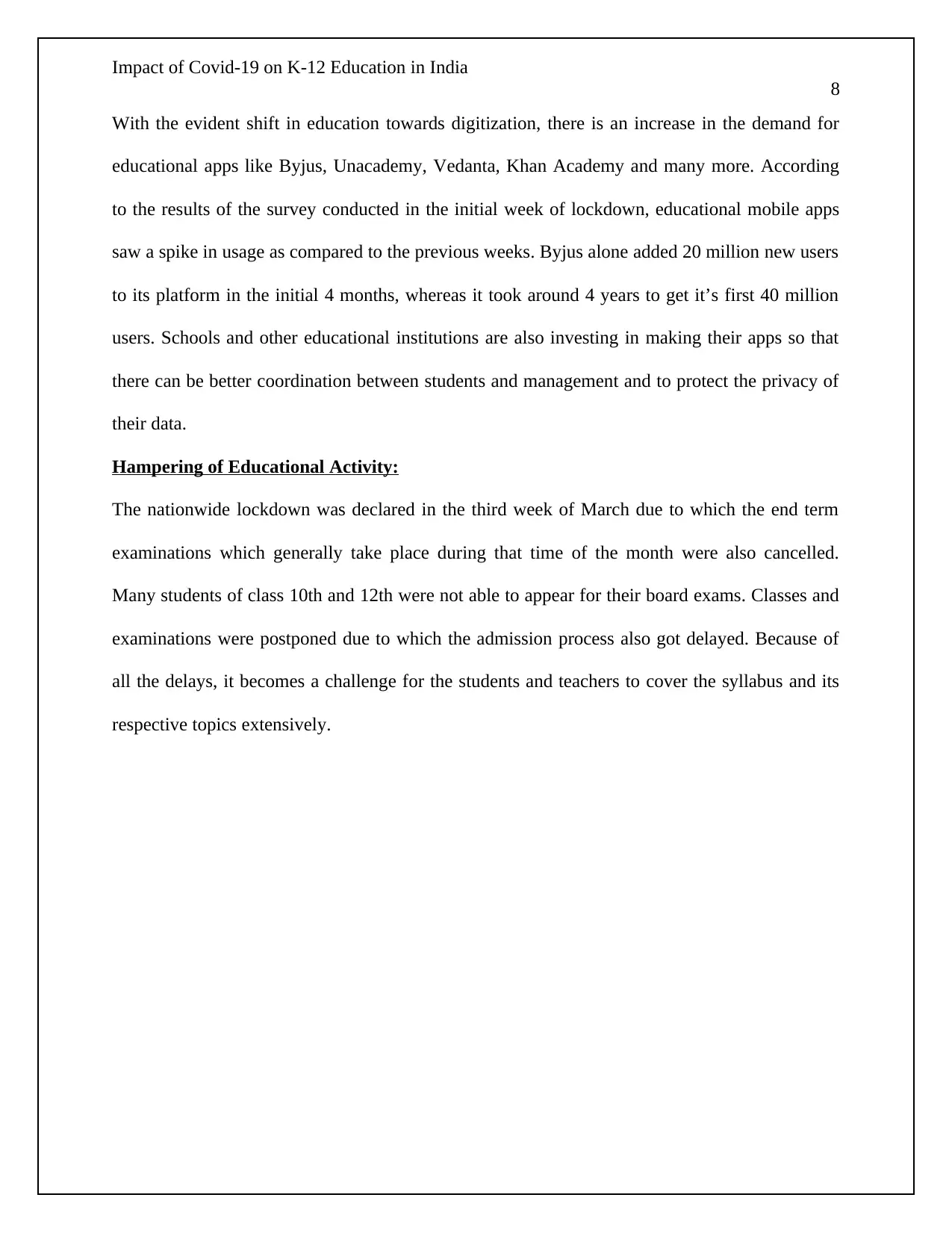
Impact of Covid-19 on K-12 Education in India
8
With the evident shift in education towards digitization, there is an increase in the demand for
educational apps like Byjus, Unacademy, Vedanta, Khan Academy and many more. According
to the results of the survey conducted in the initial week of lockdown, educational mobile apps
saw a spike in usage as compared to the previous weeks. Byjus alone added 20 million new users
to its platform in the initial 4 months, whereas it took around 4 years to get it’s first 40 million
users. Schools and other educational institutions are also investing in making their apps so that
there can be better coordination between students and management and to protect the privacy of
their data.
Hampering of Educational Activity:
The nationwide lockdown was declared in the third week of March due to which the end term
examinations which generally take place during that time of the month were also cancelled.
Many students of class 10th and 12th were not able to appear for their board exams. Classes and
examinations were postponed due to which the admission process also got delayed. Because of
all the delays, it becomes a challenge for the students and teachers to cover the syllabus and its
respective topics extensively.
8
With the evident shift in education towards digitization, there is an increase in the demand for
educational apps like Byjus, Unacademy, Vedanta, Khan Academy and many more. According
to the results of the survey conducted in the initial week of lockdown, educational mobile apps
saw a spike in usage as compared to the previous weeks. Byjus alone added 20 million new users
to its platform in the initial 4 months, whereas it took around 4 years to get it’s first 40 million
users. Schools and other educational institutions are also investing in making their apps so that
there can be better coordination between students and management and to protect the privacy of
their data.
Hampering of Educational Activity:
The nationwide lockdown was declared in the third week of March due to which the end term
examinations which generally take place during that time of the month were also cancelled.
Many students of class 10th and 12th were not able to appear for their board exams. Classes and
examinations were postponed due to which the admission process also got delayed. Because of
all the delays, it becomes a challenge for the students and teachers to cover the syllabus and its
respective topics extensively.
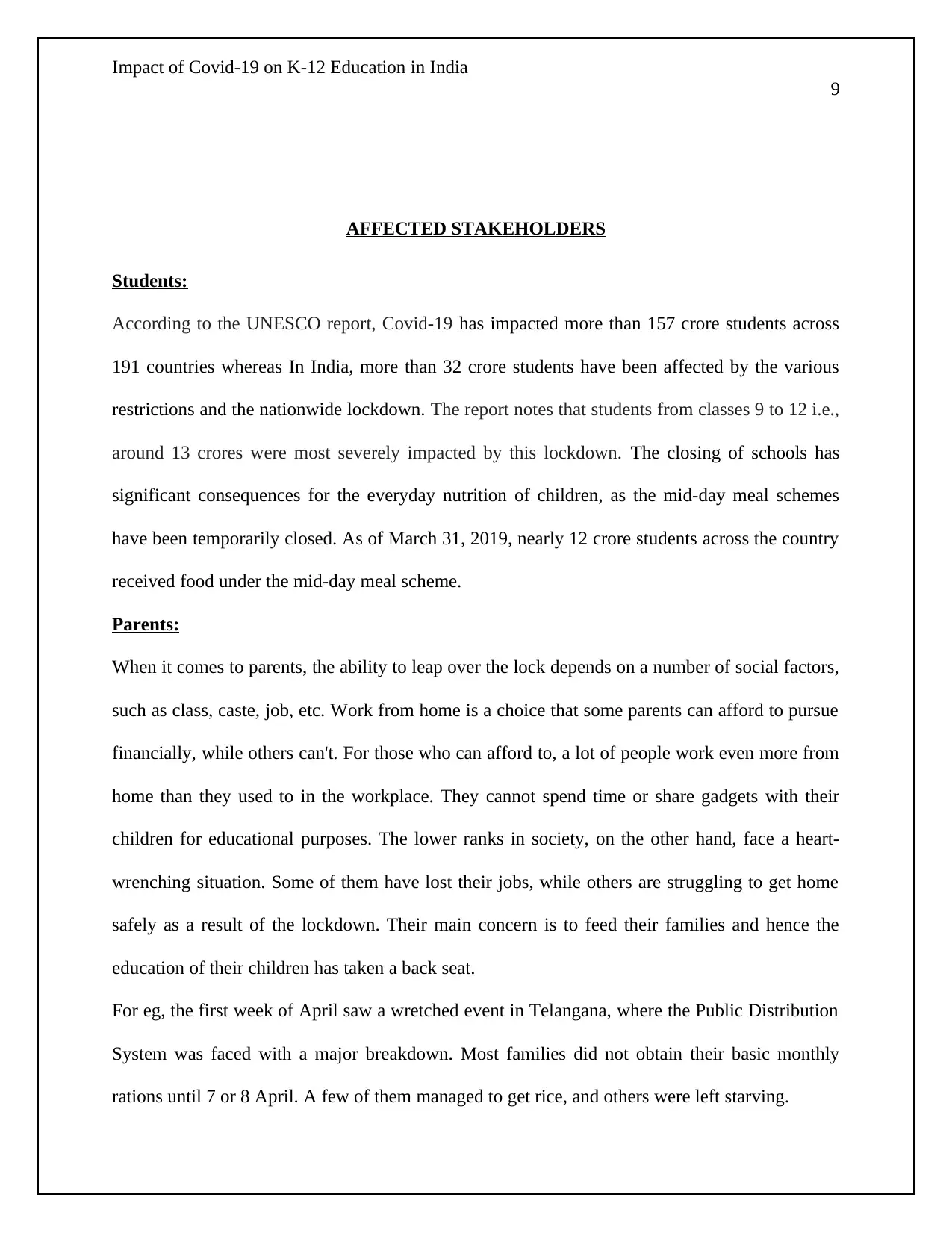
Impact of Covid-19 on K-12 Education in India
9
AFFECTED STAKEHOLDERS
Students:
According to the UNESCO report, Covid-19 has impacted more than 157 crore students across
191 countries whereas In India, more than 32 crore students have been affected by the various
restrictions and the nationwide lockdown. The report notes that students from classes 9 to 12 i.e.,
around 13 crores were most severely impacted by this lockdown. The closing of schools has
significant consequences for the everyday nutrition of children, as the mid-day meal schemes
have been temporarily closed. As of March 31, 2019, nearly 12 crore students across the country
received food under the mid-day meal scheme.
Parents:
When it comes to parents, the ability to leap over the lock depends on a number of social factors,
such as class, caste, job, etc. Work from home is a choice that some parents can afford to pursue
financially, while others can't. For those who can afford to, a lot of people work even more from
home than they used to in the workplace. They cannot spend time or share gadgets with their
children for educational purposes. The lower ranks in society, on the other hand, face a heart-
wrenching situation. Some of them have lost their jobs, while others are struggling to get home
safely as a result of the lockdown. Their main concern is to feed their families and hence the
education of their children has taken a back seat.
For eg, the first week of April saw a wretched event in Telangana, where the Public Distribution
System was faced with a major breakdown. Most families did not obtain their basic monthly
rations until 7 or 8 April. A few of them managed to get rice, and others were left starving.
9
AFFECTED STAKEHOLDERS
Students:
According to the UNESCO report, Covid-19 has impacted more than 157 crore students across
191 countries whereas In India, more than 32 crore students have been affected by the various
restrictions and the nationwide lockdown. The report notes that students from classes 9 to 12 i.e.,
around 13 crores were most severely impacted by this lockdown. The closing of schools has
significant consequences for the everyday nutrition of children, as the mid-day meal schemes
have been temporarily closed. As of March 31, 2019, nearly 12 crore students across the country
received food under the mid-day meal scheme.
Parents:
When it comes to parents, the ability to leap over the lock depends on a number of social factors,
such as class, caste, job, etc. Work from home is a choice that some parents can afford to pursue
financially, while others can't. For those who can afford to, a lot of people work even more from
home than they used to in the workplace. They cannot spend time or share gadgets with their
children for educational purposes. The lower ranks in society, on the other hand, face a heart-
wrenching situation. Some of them have lost their jobs, while others are struggling to get home
safely as a result of the lockdown. Their main concern is to feed their families and hence the
education of their children has taken a back seat.
For eg, the first week of April saw a wretched event in Telangana, where the Public Distribution
System was faced with a major breakdown. Most families did not obtain their basic monthly
rations until 7 or 8 April. A few of them managed to get rice, and others were left starving.
⊘ This is a preview!⊘
Do you want full access?
Subscribe today to unlock all pages.

Trusted by 1+ million students worldwide
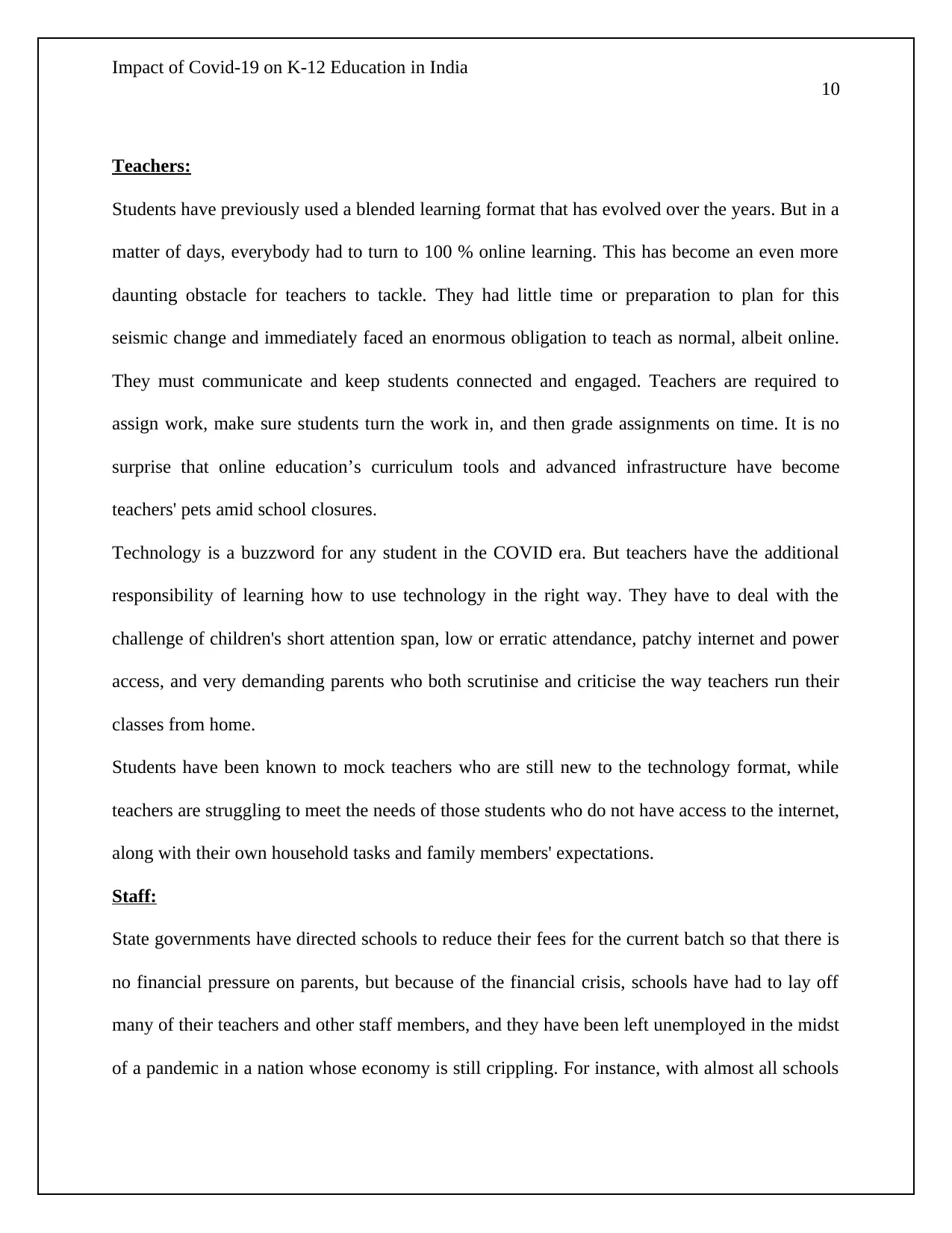
Impact of Covid-19 on K-12 Education in India
10
Teachers:
Students have previously used a blended learning format that has evolved over the years. But in a
matter of days, everybody had to turn to 100 % online learning. This has become an even more
daunting obstacle for teachers to tackle. They had little time or preparation to plan for this
seismic change and immediately faced an enormous obligation to teach as normal, albeit online.
They must communicate and keep students connected and engaged. Teachers are required to
assign work, make sure students turn the work in, and then grade assignments on time. It is no
surprise that online education’s curriculum tools and advanced infrastructure have become
teachers' pets amid school closures.
Technology is a buzzword for any student in the COVID era. But teachers have the additional
responsibility of learning how to use technology in the right way. They have to deal with the
challenge of children's short attention span, low or erratic attendance, patchy internet and power
access, and very demanding parents who both scrutinise and criticise the way teachers run their
classes from home.
Students have been known to mock teachers who are still new to the technology format, while
teachers are struggling to meet the needs of those students who do not have access to the internet,
along with their own household tasks and family members' expectations.
Staff:
State governments have directed schools to reduce their fees for the current batch so that there is
no financial pressure on parents, but because of the financial crisis, schools have had to lay off
many of their teachers and other staff members, and they have been left unemployed in the midst
of a pandemic in a nation whose economy is still crippling. For instance, with almost all schools
10
Teachers:
Students have previously used a blended learning format that has evolved over the years. But in a
matter of days, everybody had to turn to 100 % online learning. This has become an even more
daunting obstacle for teachers to tackle. They had little time or preparation to plan for this
seismic change and immediately faced an enormous obligation to teach as normal, albeit online.
They must communicate and keep students connected and engaged. Teachers are required to
assign work, make sure students turn the work in, and then grade assignments on time. It is no
surprise that online education’s curriculum tools and advanced infrastructure have become
teachers' pets amid school closures.
Technology is a buzzword for any student in the COVID era. But teachers have the additional
responsibility of learning how to use technology in the right way. They have to deal with the
challenge of children's short attention span, low or erratic attendance, patchy internet and power
access, and very demanding parents who both scrutinise and criticise the way teachers run their
classes from home.
Students have been known to mock teachers who are still new to the technology format, while
teachers are struggling to meet the needs of those students who do not have access to the internet,
along with their own household tasks and family members' expectations.
Staff:
State governments have directed schools to reduce their fees for the current batch so that there is
no financial pressure on parents, but because of the financial crisis, schools have had to lay off
many of their teachers and other staff members, and they have been left unemployed in the midst
of a pandemic in a nation whose economy is still crippling. For instance, with almost all schools
Paraphrase This Document
Need a fresh take? Get an instant paraphrase of this document with our AI Paraphraser
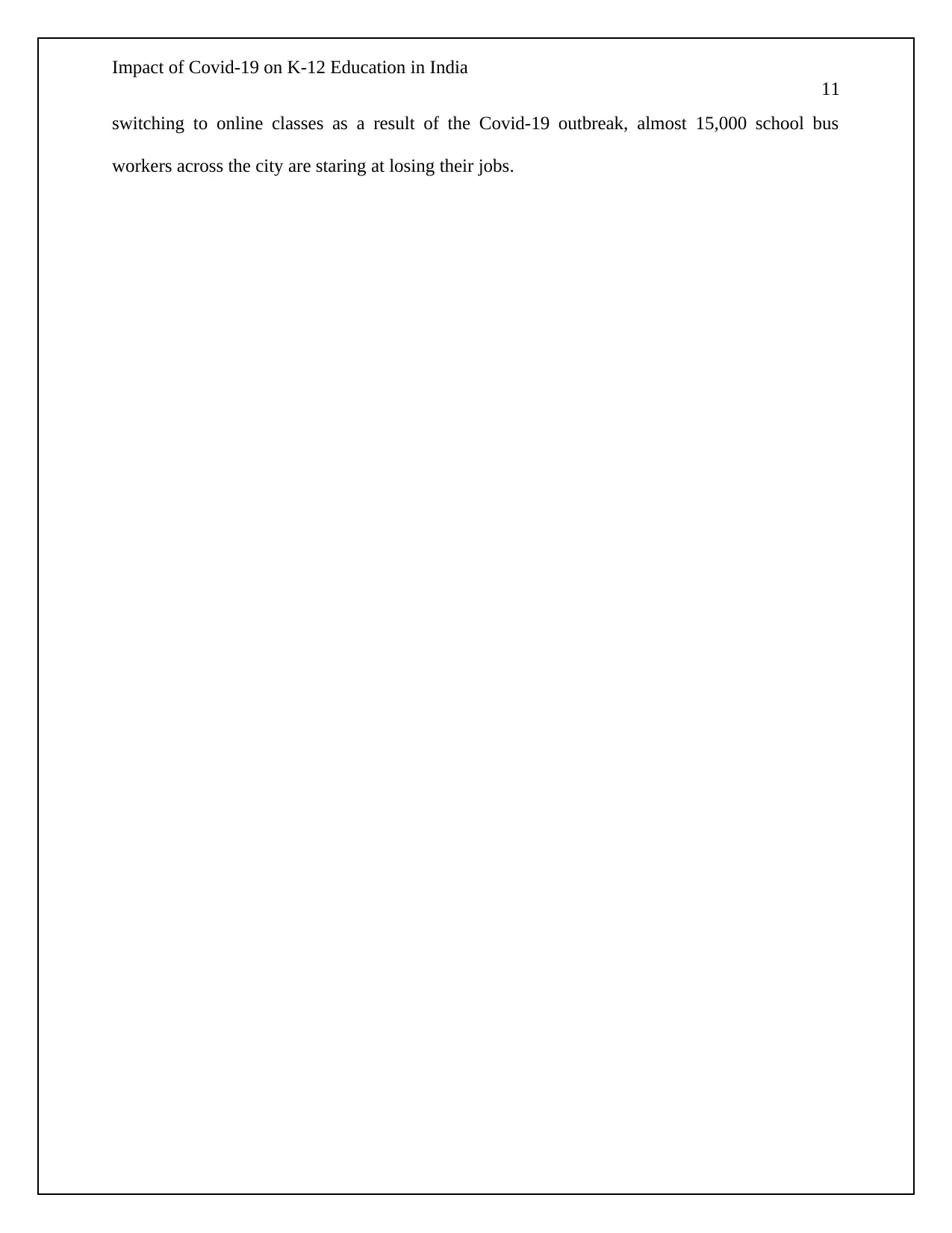
Impact of Covid-19 on K-12 Education in India
11
switching to online classes as a result of the Covid-19 outbreak, almost 15,000 school bus
workers across the city are staring at losing their jobs.
11
switching to online classes as a result of the Covid-19 outbreak, almost 15,000 school bus
workers across the city are staring at losing their jobs.
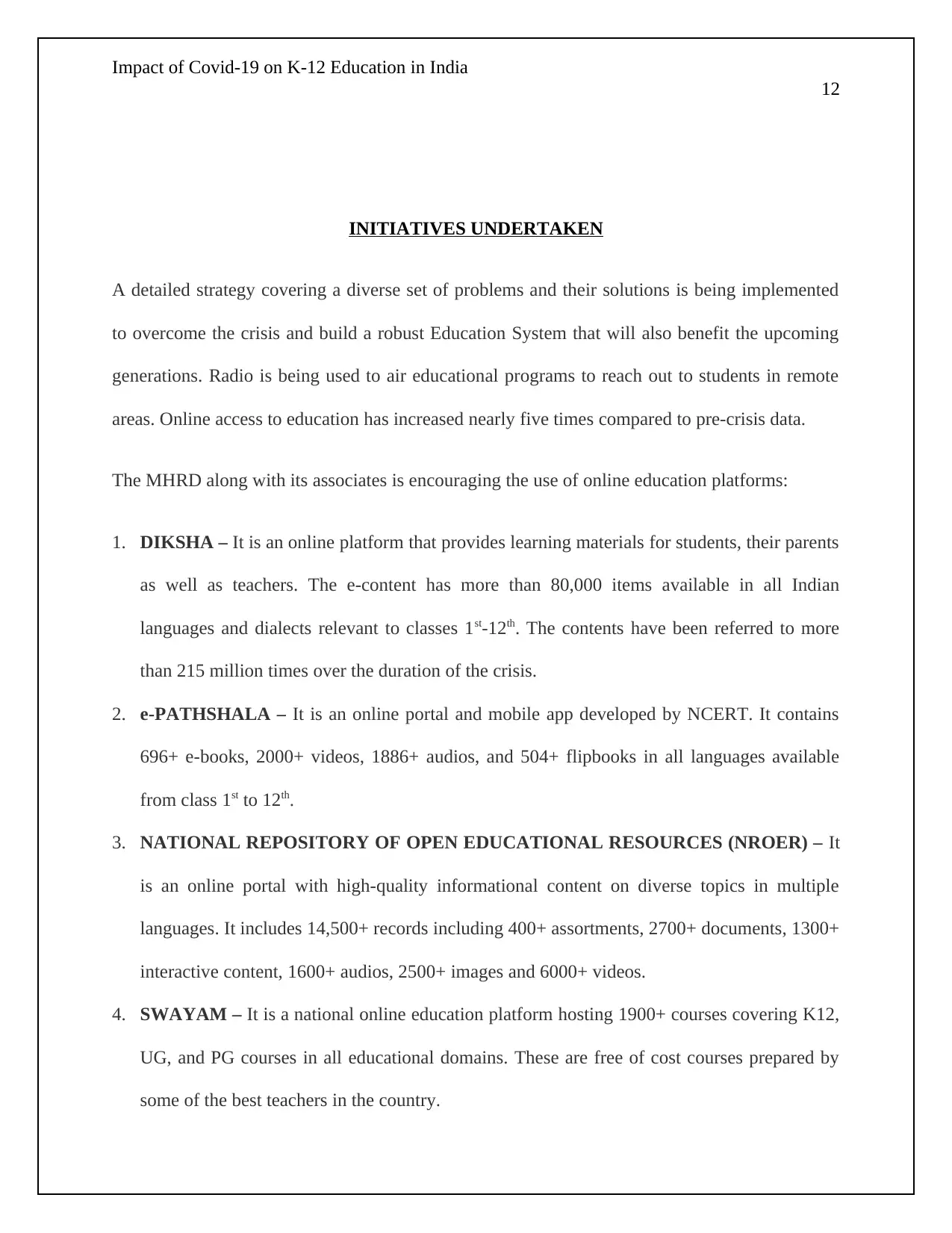
Impact of Covid-19 on K-12 Education in India
12
INITIATIVES UNDERTAKEN
A detailed strategy covering a diverse set of problems and their solutions is being implemented
to overcome the crisis and build a robust Education System that will also benefit the upcoming
generations. Radio is being used to air educational programs to reach out to students in remote
areas. Online access to education has increased nearly five times compared to pre-crisis data.
The MHRD along with its associates is encouraging the use of online education platforms:
1. DIKSHA – It is an online platform that provides learning materials for students, their parents
as well as teachers. The e-content has more than 80,000 items available in all Indian
languages and dialects relevant to classes 1st-12th. The contents have been referred to more
than 215 million times over the duration of the crisis.
2. e-PATHSHALA – It is an online portal and mobile app developed by NCERT. It contains
696+ e-books, 2000+ videos, 1886+ audios, and 504+ flipbooks in all languages available
from class 1st to 12th.
3. NATIONAL REPOSITORY OF OPEN EDUCATIONAL RESOURCES (NROER) – It
is an online portal with high-quality informational content on diverse topics in multiple
languages. It includes 14,500+ records including 400+ assortments, 2700+ documents, 1300+
interactive content, 1600+ audios, 2500+ images and 6000+ videos.
4. SWAYAM – It is a national online education platform hosting 1900+ courses covering K12,
UG, and PG courses in all educational domains. These are free of cost courses prepared by
some of the best teachers in the country.
12
INITIATIVES UNDERTAKEN
A detailed strategy covering a diverse set of problems and their solutions is being implemented
to overcome the crisis and build a robust Education System that will also benefit the upcoming
generations. Radio is being used to air educational programs to reach out to students in remote
areas. Online access to education has increased nearly five times compared to pre-crisis data.
The MHRD along with its associates is encouraging the use of online education platforms:
1. DIKSHA – It is an online platform that provides learning materials for students, their parents
as well as teachers. The e-content has more than 80,000 items available in all Indian
languages and dialects relevant to classes 1st-12th. The contents have been referred to more
than 215 million times over the duration of the crisis.
2. e-PATHSHALA – It is an online portal and mobile app developed by NCERT. It contains
696+ e-books, 2000+ videos, 1886+ audios, and 504+ flipbooks in all languages available
from class 1st to 12th.
3. NATIONAL REPOSITORY OF OPEN EDUCATIONAL RESOURCES (NROER) – It
is an online portal with high-quality informational content on diverse topics in multiple
languages. It includes 14,500+ records including 400+ assortments, 2700+ documents, 1300+
interactive content, 1600+ audios, 2500+ images and 6000+ videos.
4. SWAYAM – It is a national online education platform hosting 1900+ courses covering K12,
UG, and PG courses in all educational domains. These are free of cost courses prepared by
some of the best teachers in the country.
⊘ This is a preview!⊘
Do you want full access?
Subscribe today to unlock all pages.

Trusted by 1+ million students worldwide
1 out of 17
Your All-in-One AI-Powered Toolkit for Academic Success.
+13062052269
info@desklib.com
Available 24*7 on WhatsApp / Email
![[object Object]](/_next/static/media/star-bottom.7253800d.svg)
Unlock your academic potential
Copyright © 2020–2025 A2Z Services. All Rights Reserved. Developed and managed by ZUCOL.


